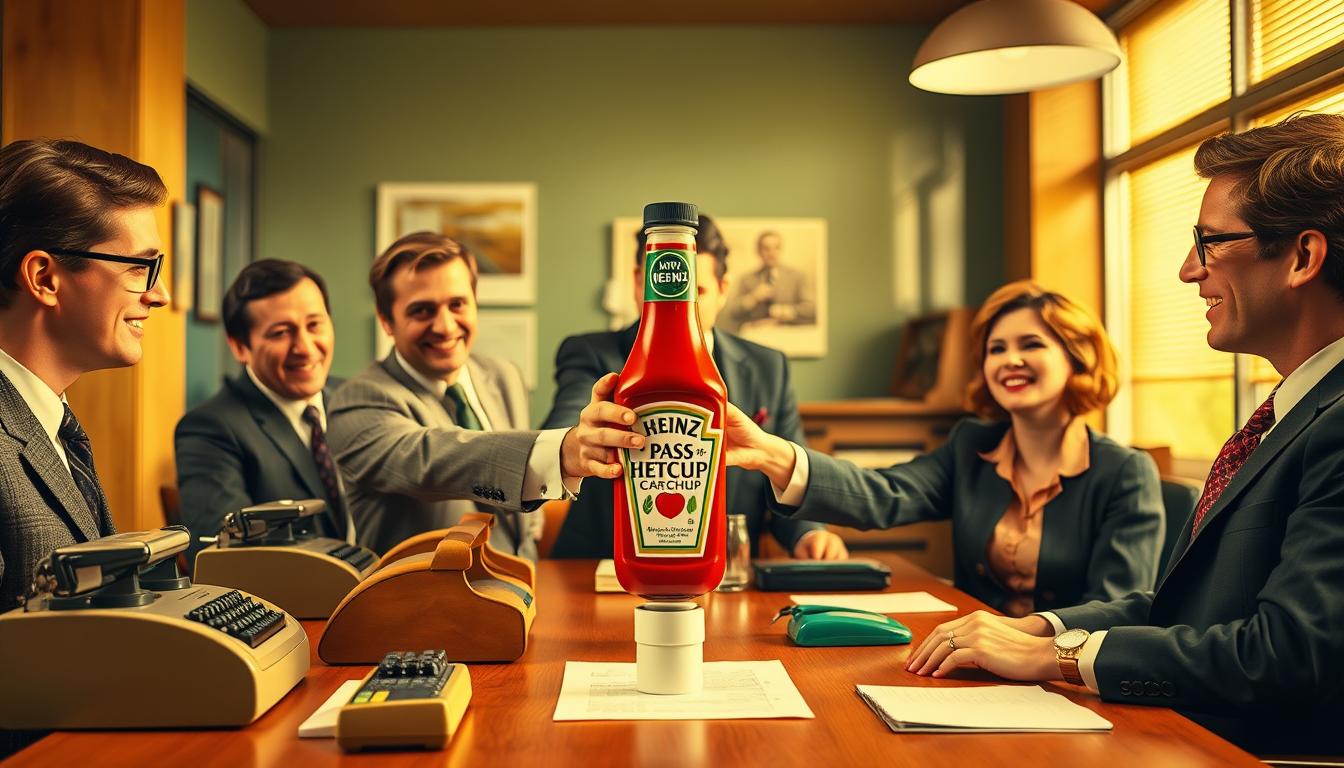
Imagine a world where advertising was as simple as a single, powerful visual. This is the world that Don Draper envisioned in a memorable episode of Mad Men, where he pitched an ad with no product in sight. Now, Heinz is bringing that bold idea to life with its “Pass the Heinz” campaign, blending nostalgic charm with modern simplicity.
The campaign, which has gained attention across print, social media, and New York billboards, captures the essence of retro marketing while speaking to today’s consumers. By focusing on mouthwatering visuals rather than lengthy copy, Heinz creates a minimalist yet impactful communication that resonates with both long-time fans and new audiences. This approach, rooted in decades-old creative genius, is reinterpreted for the modern market, proving that sometimes, less truly is more.
As explored in nostalgia marketing, campaigns like this one evoke a sense of familiarity and comfort. Heinz’s strategy isn’t just about selling ketchup—it’s about creating a connection through shared experiences and memories. This innovative approach to advertising is a testament to how creative ideas can transcend time, making the brand’s message as relevant today as it was decades ago.
Heinz Pass the Heinz Campaign
In the sixth season of Mad Men, Don Draper and Stan Rizzo presented a bold idea to Heinz executives: an ad featuring only food, without the ketchup bottle. This minimalist approach was initially met with skepticism, but its simplicity struck a chord.
The Mad Men Inspiration Behind the Pitch
The original pitch was deemed “half an ad” by Heinz executives, yet it captured the essence of bold, minimal advertising. Don Draper’s vision, though rejected at the time, has now been brought to life by Heinz with the help of ad agency David Miami.
Reimagining a Classic with Modern Simplicity
Today, Heinz has reimagined Draper’s concept for the modern era. The campaign, which includes print ads in major publications like Variety and the New York Post, as well as a prominent billboard in New York, has garnered significant attention. Nicole Kulwicki, a marketing expert, noted, “The campaign’s success lies in its ability to evoke nostalgia while maintaining modern appeal.”
The connection between the fictional Sterling Cooper Draper Pryce and Heinz’s real-life revival is a testament to the timeless power of creative ideas. By focusing on mouthwatering visuals, Heinz creates a minimalist yet impactful communication that resonates with both long-time fans and new audiences.
For more details on the campaign, visit Canadian Grocer.
| Aspect | Original Pitch | Modern Execution |
|---|---|---|
| Visual Focus | Food without the product | High-quality food images |
| Medium | Print, Social Media, Billboards | |
| Agency | Sterling Cooper Draper Pryce | David Miami |
Innovation Lessons: From Myspace’s Failure to Facebook’s Rise
The rise and fall of social media giants like Myspace and Facebook offer valuable insights into innovation and user experience. While Myspace struggled with cluttered interfaces and poor strategic decisions, Facebook thrived by focusing on simplicity and clear purpose.
Understanding Myspace’s Downfall
Myspace’s decline can be attributed to its cluttered and complicated user interface. The platform allowed excessive customization, which often led to a chaotic user experience. Additionally, Myspace made ill-advised acquisitions and failed to innovate, leaving it vulnerable to competitors. These missteps ultimately drove users away, making room for Facebook’s ascent.
Zuckerberg’s Strategic Vision
Mark Zuckerberg’s approach was vastly different. Facebook focused on a clean, minimal design that emphasized user-friendly navigation. This strategic simplicity, combined with purposeful innovation, propelled Facebook to global dominance. The platform’s success underscores the importance of prioritizing user experience and strategic growth.
Relating Lessons to Modern Campaigns
These innovation lessons are mirrored in campaigns like Heinz’s “Pass the Heinz.” By focusing on clean visuals and impactful messaging, Heinz achieves a minimalist yet effective communication strategy. This approach resonates with audiences, much like Facebook’s design philosophy.
| Platform | Myspace | |
|---|---|---|
| Visual Focus | Cluttered, customizable profiles | Minimalist, user-friendly design |
| Strategy | Poor acquisitions, lack of innovation | Strategic innovation, clear purpose |
| Outcome | Decline due to user dissatisfaction | Global dominance through simplicity |

New York Media Impact: From Print to Billboards
New York City became the vibrant stage for Heinz’s “Pass the Heinz” campaign, blending traditional print and outdoor media with bold real-world stunts. This approach captivated the urban audience, showcasing the brand’s ability to merge retro charm with modern appeal.
Captivating City Campaign Execution and Real-World Stunts
The campaign debuted on New York billboards and in major print publications like Variety and the New York Post. High-impact ads featured mouthwatering images of fries and burgers, accompanied by the striking “Pass the Heinz” tagline, creating a minimalist yet powerful communication strategy.
Real-world stunts added authenticity and buzz. For instance, a pop-up diner in Manhattan offered free fries with a side of ketchup, drawing long lines and social media attention. These activations highlighted the campaign’s effectiveness in engaging the public.

Media expert Sarah Johnson praised the campaign, stating, “The simplicity and nostalgic appeal of ‘Pass the Heinz’ have resonated beautifully with New Yorkers, proving that sometimes, less is indeed more.”
For more insights into the campaign’s execution, visit MRMP.pro.
| Aspect | Original Pitch | Modern Execution |
|---|---|---|
| Visual Focus | Food without the product | Iconic food imagery |
| Medium | Print, Billboards, Social Media | |
| Agency | Sterling Cooper Draper Pryce | David Miami |
Conclusion
Heinz’s “Pass the Heinz” campaign is a masterclass in blending retro charm with modern strategy. Inspired by Don Draper’s bold pitch in Mad Men, the campaign has evolved from a fictional idea to a real-world success, captivating audiences across print, social media, and billboards.
Nicole Kulwicki, Heinz’s head, highlights the campaign’s ability to evoke nostalgia while maintaining modern appeal. Media outlets like Adweek and Business Insider have praised its simplicity and effectiveness, drawing parallels to how Facebook’s minimalist approach led to its dominance over cluttered platforms like Myspace.
The campaign’s ethos—focusing on striking visuals and impactful messaging—transcends decades and media formats. It challenges you to reflect on key moments where simplicity triumphed over clutter. Whether you’re a Mad Men fan or new to the brand, this campaign stands out as a celebration of retro inspiration meeting modern innovation.
Explore more about how e-commerce SEO strategies can enhance your brand’s digital presence and learn how to create campaigns that resonate across generations.

 Heinz Pass the Heinz: Reviving Mad Men’s Retro Marketing Appeal
Heinz Pass the Heinz: Reviving Mad Men’s Retro Marketing Appeal
0 Comment